This guide explains the exact process we used to sell $980,030.90 worth of information (online) to gardeners in just under 2 years. Since this is a gigantic post (WordPress tells me it’s 12,468 words), I’ve created a Table of Contents to help you navigate.
Table of Contents
- Introduction
- System #1: Automated Lead Generation
- System #2: Autopilot List-Building
- System #3: Multiplying Profits
- Conclusion
Before we get started, let me ask you a question…
Why are you reading this article?
My guess is… to have more freedom in your life.
That’s most likely the underlying reason you decided to click through and read. Am I right, or am I right?
Whether you want to optimize the info-business you already have or start one from scratch, your biggest over-arching desire is FREEDOM.
More specifically, financial freedom. Freedom to wake up when you want, go to “work” when you want, go on vacation when you want, spend time with your family when you want. Just plain old freedom.
How do I know that? Well, first off, I’m good like like that…
…but secondly, I know my prospect like the back of my hand (which is the number one rule in info-marketing and you’ll learn how to do it yourself right here on this page).
So, I want you to get excited. I mean really get EXCITED! There is REAL hope for you here to finally make a steady income online. I’m honored to be the one to share it with you. But I want you to know…
This isn’t some BS push-button scheme. The stuff I’m sharing with you here on this page are PROVEN, time-tested methods my dad and I have used to build a REAL online business selling information products.
This isn’t something we’ve only been doing for a couple of years either. My dad started this business himself back in 1999, barely knowing how to operate a computer! Today, we’re still selling the same product, from the same website to the same type of prospects.
This blueprint is as evergreen as evergreen gets. And that’s where I’m going to crush our first myth…
(Throughout this little guide, I’ll “de-myth” a few of the most common beliefs in the info-marketing world.)
Myth #1: Evergreen Niches Are the Easiest
There ARE NO evergreen niches. Here’s what I mean by that… of course, there are niches where the solution to the problem doesn’t change.
For example, the Caring for Cichlids niche (Cichlids are a type of aquarium fish). The methods/tips/tricks/strategies you use to care for Cichlids will be the same now as they will be 10 years from now.
People call this an “Evergreen Niche”. They think by choosing evergreen niches, they can get the business all setup online and it will run on autopilot forever without ever having to touch it again.
But they’re wrong. My dad and I are in an “Evergreen Niche” (gardening). We are constantly tweaking and fine-tuning our business on a daily basis.
We always have split-tests going, we’re always trying to improve conversion rates, increase subscriber opt-in rates, create new products, new funnels, new lead magnets, new autoresponder sequences, and much, much more (don’t worry if you didn’t understand any of that, I’ll explain what all of this stuff is shortly).
Never settle for the results you’re getting. There’s always someone out there doing better than you.
Alright, let me explain how I laid out all of this info and how you can use it to get the best results.
So many people complicate this business with stuff you don’t need, steps you don’t need to take, and software that isn’t necessary.
My main goal when I set out to write this guide was to simplify this entire business and make it so dang simple that ANYONE could do it.
I did just that. Start to finish, there are 3 major systems required to make this entire business run. Yes, just 3.
Now, each system has its own set of rules and processes but by dividing it into 3 separate systems, it’s much easier to understand.
To mimic the business model, this guide is also divided into 3 specific systems called… Automated Lead Generation, Autopilot List-Building, and Multiplying Profits.
IMPORTANT: Each of the 3 systems are completely stand-alone and operate without any assistance from the other two. BUT, for the business to run properly, you must learn how to connect them together accordingly.
Everything from here on out will fall into one of these three categories.
It’ll make much more sense once we dive in and start dissecting each system. I promise you it’s much easier than you think!
System #1: Automated Lead Generation
Know Your Prospect Inside and Out
The Internet is literally a sea of people. They’re not all good prospects for what you have to sell.
People are interested in different things, much like fish. One bait might work well for catching Tuna but is worthless when trying to catch Trout.
The same goes for potential prospects online.
You need to know what turns them on, what it is they’re searching for, and why they’re hunched over a computer screen at 11 o’clock at night looking for answers.
In order to attract leads to your site, you first need to know what problems they’re facing, what burning desires they have, what’s keeping them up at night, and what it is they think of as soon as they wake up.
You have no business going any further with this until you can answer those questions.
No matter what you do, never ever start with a product in mind. People don’t want products. They want solutions. Start with a problem and work your way up.
It always helps if you have experience in the niche you’re interested in but it’s definitely not required.
My dad and I have a former mastermind friend who purchased an existing online info-marketing business that helps people start a daycare.
She’s never owned a daycare before and never has any intentions of owning a daycare. She’s doing very well and has turned it into a very profitable info business.
So, experience is definitely not required but if you don’t have experience, you’ll need to do some homework to answer the questions I asked above.
That is required.
As I go through this, I’m going to choose a niche to use as an example. I just think it’s so much easier to learn by example.
I will show you how to do each step by actually doing it myself with the niche I choose.
The niche I’ll be using is The Photography Business niche (my wife is a photographer and I already know a lot about the business from helping her).
Start Researching the Niche
Please don’t make this harder than it needs to be. Seriously. It’s not rocket science. First, you need to make sure you enter a niche that lends itself to info-products (most do, some don’t).
I have a few tests you can take to help validate your desired niche.
Ready? Here ya go…
Test #1: The If-Test
Your niche is GREAT for info-products IF any of these apply:
- it’s a business with an average transaction size of more than $100
- there’s a magazine made just for the niche (use amazon.com to browse through all the different magazines, there are TONS)
- it’s in one of these 3 categories… Health, Wealth or Relationships
My Photography Business niche actually passes all 3 of these “if-tests”. It’s a business with a transaction size of more than $100.
Look at how many magazines there are under photography… 265!
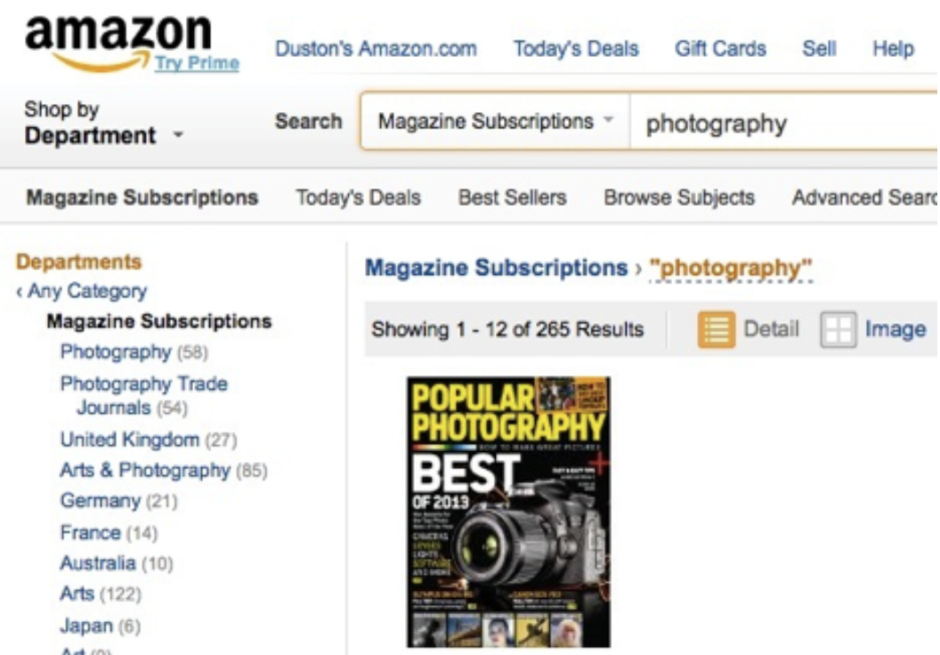
And, it’s in the Wealth category since it’s a business and the main goal of a business is to make money.
Now, those three If-Tests qualify your niche as being GREAT for info-products. If your niche doesn’t qualify for one of those, that doesn’t mean it won’t work.
What those three tests really do is check to make sure money is being spent on products in those areas, or at least that there IS money to be spent.
The last thing you want to do is enter a niche, spend tons of time researching and creating products only to find out people won’t spend money on them.
Ideally, you want to enter a niche where there are multiple problems you can solve (ie. you can sell multiple products to the same person, you’ll learn more about that when I go into System #3).
Remember, this guide isn’t about setting up 10 or 20 info-product sites all selling $7 reports.
I’m showing you how to build a REAL online business in a single profitable niche.
You will make more money if you can focus on one niche and go narrow and deep instead of going wide and shallow in 20 different niches.
It’s hard to keep up with changes in 20 different niches. You’ll never have the chance to work ON the business. You’ll constantly be working IN the business.
Test #2: Competition Analysis
As much as you hate to hear that there’s competition in your niche, it’s required for this to work.
Being the first guy to bring something to market sucks. There’s too much risk for someone just getting started.
Go where the money is already changing hands and the demand is plentiful.
Let me give you a real-life example of this…
When Home Depot is looking to open a new store somewhere, they don’t look for areas where there are NO other home improvement stores. They look for cities where Lowe’s already has a location but they don’t.
If a city is populated enough to be able to support a Lowe’s store, Home Depot knows they can sneak in a steal a large chunk of their business.
Competition is a good thing. It means the demand is already there.
There are tons of ways to check for competition in your niche. You can start by doing a quick search in Google for your niche and see if anyone is paying for ads.
Here’s what shows up when I search Photography Business…
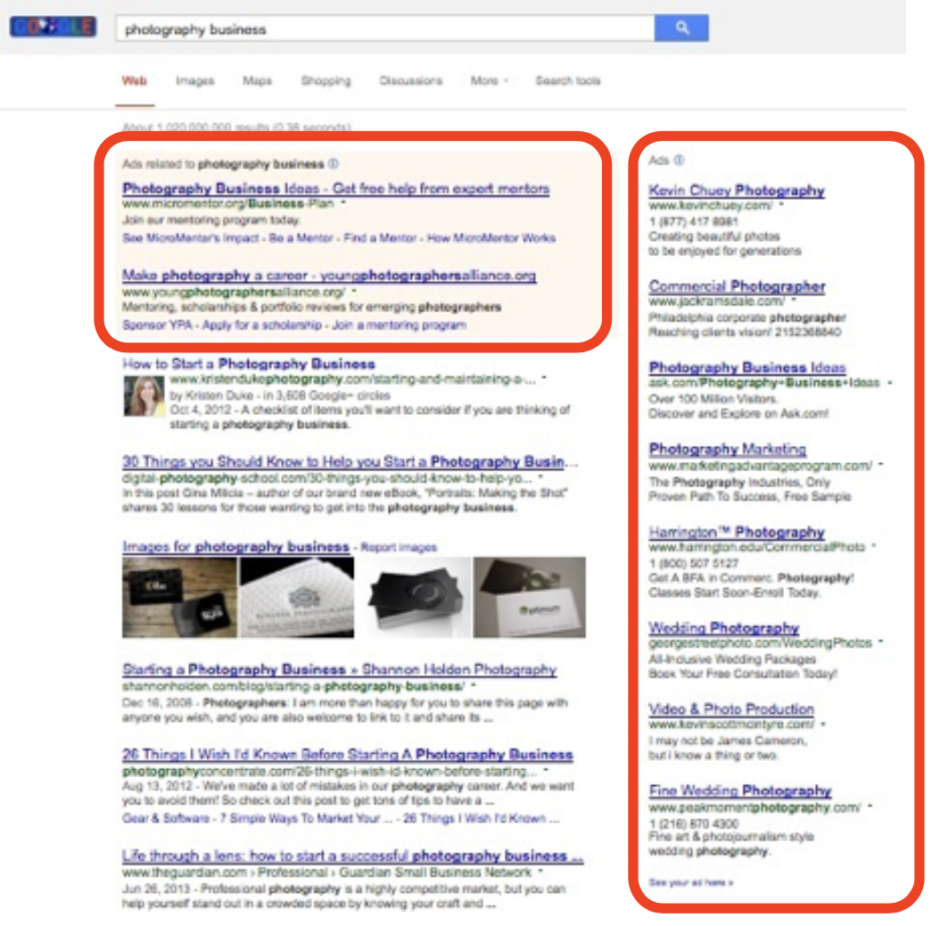
Ads all over the place! Now, some aren’t relevant to my search for Photography Business but I can’t help that. Those people are bidding on those keywords in Google AdWords out of pure ignorance. You can run the same competition test in Bing or Yahoo just to verify.
Another way to test for competitive analysis is to use Facebook. This is a bit harder and takes more time but you should still do it.
Log into your Facebook account and start searching for and “liking” pages related to your niche.
Over the next few days, pay close attention to the ads that are displayed to you. If they’re related to your niche, take a screenshot of them or make a note of it.
The goal is to determine if people are spending money on Facebook Ads promoting offers in your niche.
If you use Facebook from your desktop computer, you’ll see ads on the right side and directly in your News Feed.
If you use Facebook mainly from your mobile device, you’ll only see ads in your News Feed. Here’s an ad from my news feed…
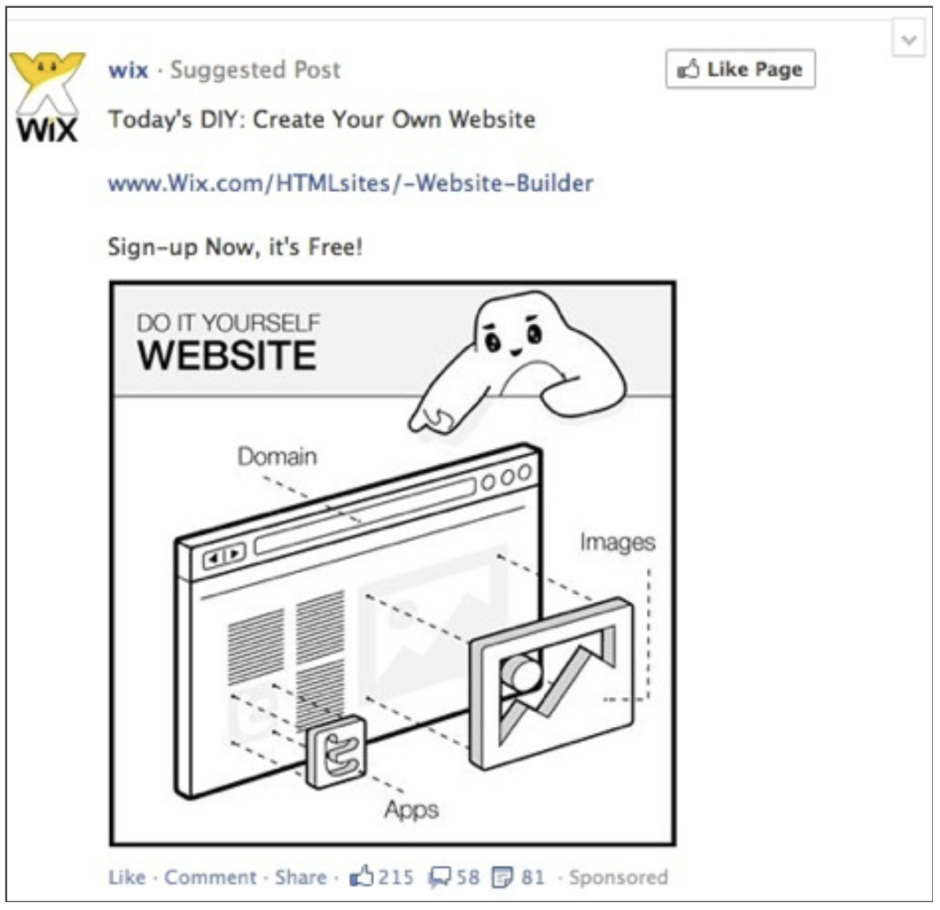
As for competition analysis, that’s as far as you really need to go. If you didn’t find any competition using those two methods, I highly suggest going a different direction.
It’s not to say your niche isn’t profitable, it will just be harder to get started. Having competition is kind of like having a cheat sheet during a test at school. Why do all that work when someone else has done it for you?
Take the easy road here and trust me when I say, starting an info-product business online in a “untapped niche” is no walk in the park.
There are too many unknowns…
- Is there demand?
- Is there enough demand?
- Will they pay for information?
- How much will they pay for information?
- Do they buy stuff online?
- What’s the best traffic source?
- How much is the Lifetime Customer Value?
That’s just a glimpse into the number of unknowns you’ll face when entering a brand-new, untapped niche.
Is it impossible? No. Will it be difficult? Yes. Absolutely.
The choice is yours… choose a niche where you know the answer to those questions upfront (or you can at least find the answers with a little research) or, choose the hard road and venture out into the great unknown world of untapped niches.
Make your decision now, before moving on to the next step.
Using the Right Bait Piece
Lets move on to your “bait piece”, or sometimes referred to as the lead magnet.
I’m sure you’ve seen many different websites offer something for free in exchange for your name and email address.
Here are just a few examples of some bait pieces I’ve come across:
Harbor Freight Email Offer
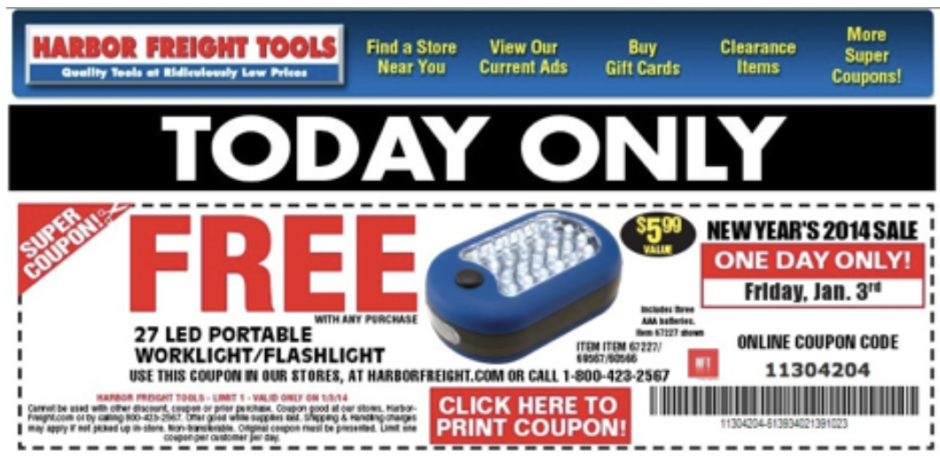
While this isn’t an example of a lead magnet in exchange for a name and email, it’s still a good example.
Harbor Freight is always sending coupons and offers like this to get people into their store. This one is a free flashlight, no other purchase is required.
They know that if they can get someone into the store, they’re going to spend money.
QuickSprout Lead Magnet
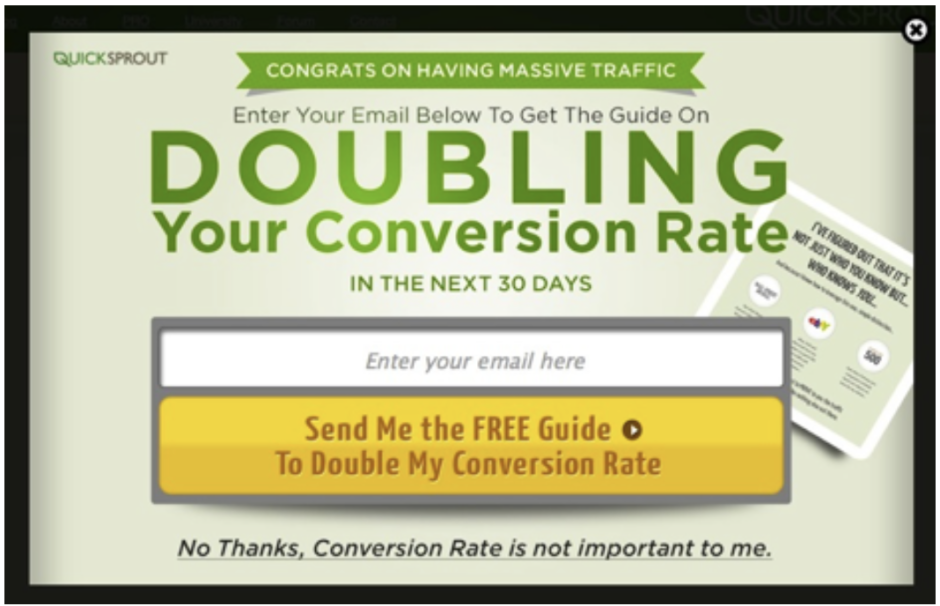
Neil Patel runs QuickSprout, a blog about marketing online. He does a great job here of making a clear offer in exchange for your email address.
This is a popup box that pops up every time you visit the site within the first few seconds.
When you try to leave his site, this popup appears…
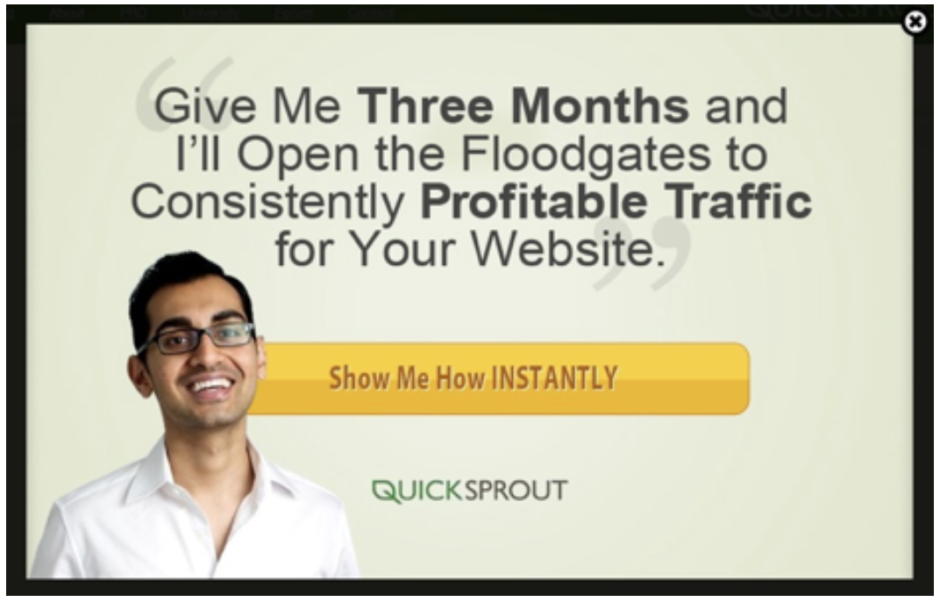
Clicking the ‘Show Me How INSTANTLY’ button takes you to a sales page for his info-product.
Expert Photography Example
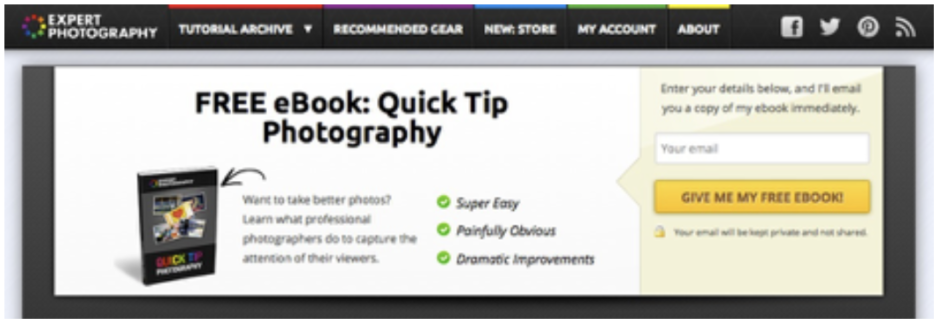
This lead magnet is at the top of the Expert Photography blog homepage. They also have an exit-popup box that plays a video which asks for a name and email.
Our Gardening Lead Magnet
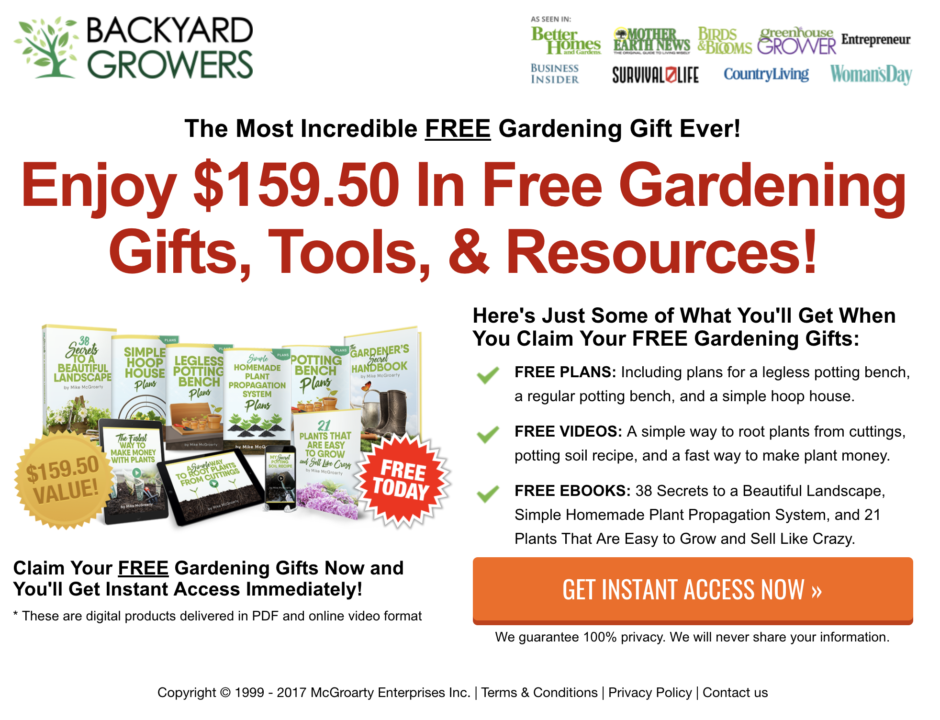
We’re constantly split-testing different squeeze pages (a squeeze page is a page on your site dedicated to capturing the visitor’s contact information and nothing else – similar to a landing page).
This variation above is currently our highest converting page. Visitors land here by clicking an ad that on our blog.
Here’s a few of the ads for this lead magnet on our blog…
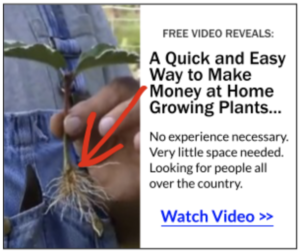
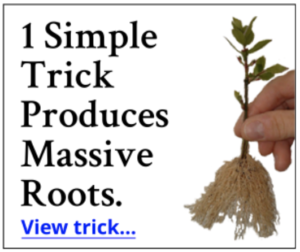
The Lead Magnet Doesn’t Have to Be Free
In fact, using a low-priced lead magnet is a great way to attract people willing to spend money rather than “freebie seekers”.
Keep one thing in mind though…
Everybody spends money on something. So even though you might not want to build a list of “freebie seekers”, those freebie seekers are spending their money on something each and every month. Figure out what that is and offer it to them.
Our list of gardeners are a perfect example. They all join our list for free. We give them tons of advice every week, some buy our product, some don’t.
Every now and then we’ll promote a few random products to get money from people who have no interest in our product.
We’ve sold them Internet Marketing products, Get Out of Debt products, Online Software products and more.
So, like I said earlier, low-priced lead magnets are a great way to build a list of interested buyers.
The key is to choose the right low-priced lead magnet. Here a few examples:
Photography Business Example
Using my Photography Business example, photography props are an excellent low-priced lead magnet.
These hand-knitted newborn props are available to buy on AliExpress for $10 or less with free shipping.

I would sell them at cost to generate a “buying lead”, then upsell them info-products on how to make more money with their photography business.
GoDaddy Example

GoDaddy has ran a low-priced lead magnet for years by selling domain names for only $.99. If you’ve purchased a domain name from them you’re well aware of their upsell process.
By the time you’ve completed your registration, you’ve been offered AT LEAST 5 different upsells… BEFORE you checkout.
They know how much a customer is worth to them over the lifetime of their relationship together so they know how much they can spend to acquire them on the front-end.
VistaPrint Example
VistaPrint has also been playing the low-priced lead magnet game for years with their 250 free business card offer (just pay shipping and handling).
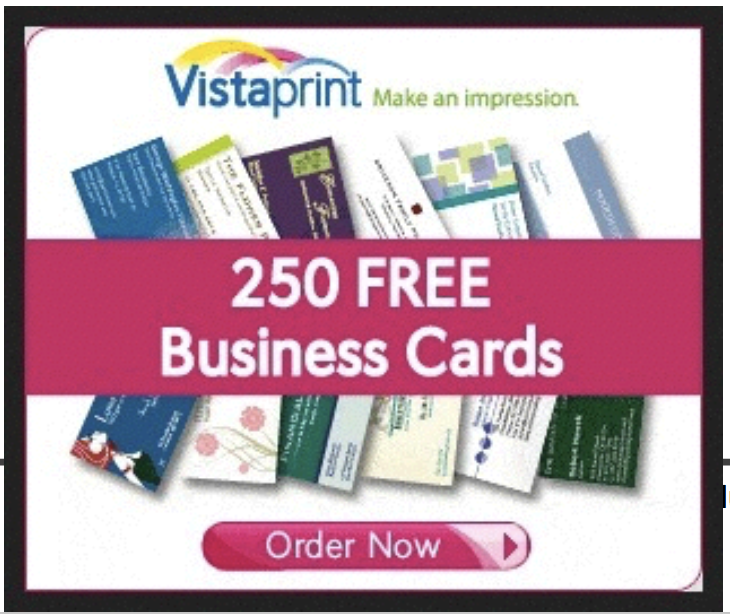
They’re another company who has an endless amount of upsells once you get into their funnel.
They know their numbers and know how much they can spend to acquire a customer. You catchin’ on to how this works?
Don’t look at the low-priced lead magnet as a way to make money. It serves the same purpose as giving away something for free in exchange for a name and email. Except the low-priced offer is only to attract buyers.
That’s as far as we’ll go right now with bait pieces (lead magnets). As we move into System #2, we’ll go into more detail about what to do after someone raises their hand for your lead magnet. That’s where it really gets good!
Keep Them On Your Landing Page
I’m referring to the landing page you send your traffic to, “them” being your visitor. One of the most common mistakes I see in the info-marketing world is poor landing page optimization.
Before I go any further, let me clarify what I mean by landing page.
In the info-marketing world, a landing page is a stand-alone web page on your site where you send traffic to for a specific offer. This can be a squeeze page or a sales page.
The structure of a landing page should follow these 5 important rules:
- There should be no navigation
- There should be a clear and concise offer
- There should be an obvious call-to-action
- The landing page should be congruent with the ad that got the visitor to the page
- The area “above-the-fold” should be used efficiently
A successful landing page should follow these 5 rules to achieve maximum results. I’ll go through each of these 5 rules in more detail.
1. There should be no navigation
When you send people to your landing page, you want them to stay there until they take action. By distracting them with links and navigation you will lower your conversion rate tremendously.
2. There should be a clear and concise offer
Don’t make this hard for people. Tell them exactly what they’re getting by taking action. Make it easy to understand and easy to complete.
3. There should be an obvious call-to-action
A call-to-action is exactly what it sounds like, you’re telling your visitor what to do. People want direction and you should be the one to give it to them. Use arrows, bold text and eye-catching copy and make them an offer they can’t refuse.
4. The landing page should be congruent with the ad that got the visitor to the page
This is very important. When someone clicks a link online, they expect to land on a relevant page. If your ad tells them to sign-up to get a free ebook on learning the guitar, your landing page better include similar language.
This is why it’s so important to send people to specific landing pages for each one of your offers. You don’t want to send all of your traffic to your homepage and hope that the visitor will find their way to the right page.
Instead what will happen is the visitor will land on the homepage, briefly scan left to right and click the back button because they didn’t find what they were expecting to find.
Remember, make it easy for them to take action.
5. The area “above-the-fold” should be used efficiently
The term above-the-fold means… the area on your landing page that the visitor sees immediately after arriving without scrolling down.
Everything above the bottom part of your screen is considered to be “above-the-fold”. And, it’s important that you take advantage of that space.
Avoid using big header images, navigation bars or other space-wasting objects. Instead, use this space to make your clear and concise offer and maybe even your call-to-action.
Here are some examples I’ve saved that I consider to be good landing pages…
Our Gardening Squeeze Page
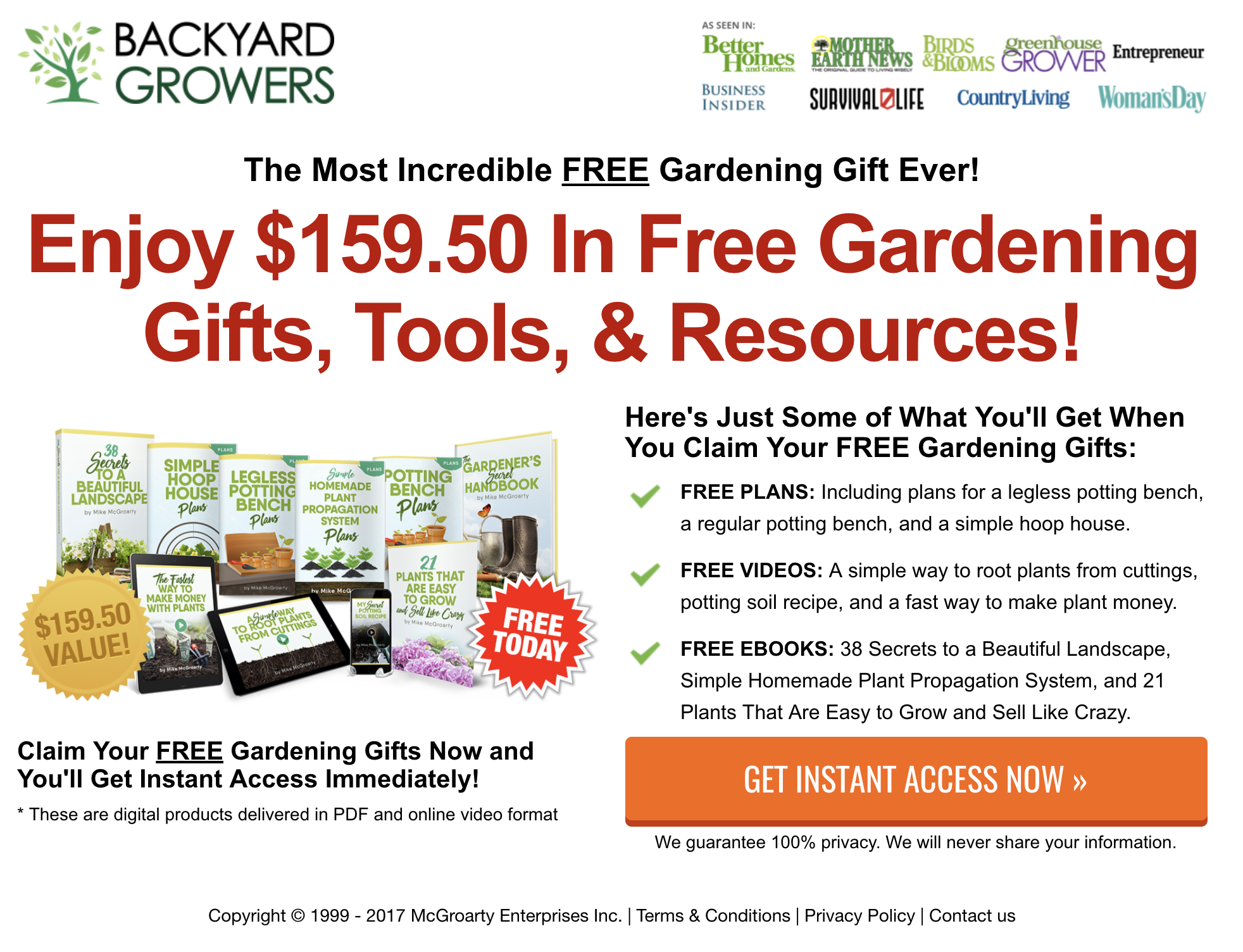
Like I mentioned earlier, we’ve tested the crap outta this page and this is our highest converting design. Everything is above-the-fold, there’s a clear and concise offer, a call-to-action and no navigation (other than the legal pages which open in a new window).
The Motley Fool Example
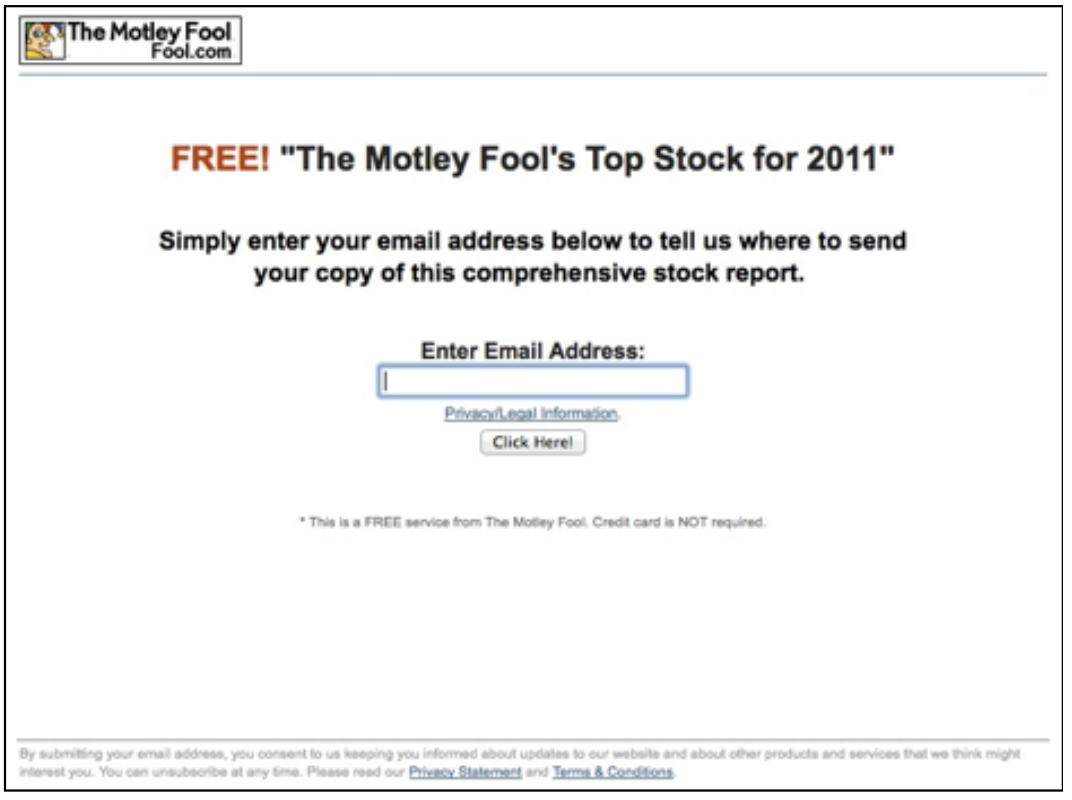
This is one of my favorite squeeze pages because of its simplicity. Brilliant.
It’s simple, with a clear and concise offer, no navigation, everything is above-the-fold and there’s a clear call-to-action. Just perfect!
Where to Get Landing Page Inspiration?
You can find some pretty decent ones using Google. Just type in Squeeze Page Examples. Hit search and then choose the Images tab to only show images.
You’ll see an endless amount of squeeze page examples that you can take and make your own.
Traffic & Tracking
To generate leads, you need traffic to your website. Most people think traffic is the holy grail of info marketing online. They think it’s the secret sauce.
“If I could just get 10,000 visitors to my site each month, I’d be set.”
Boy they couldn’t be more wrong.
Myth #2: Traffic Generation is the Secret to Info-Marketing Online
Anyone can pay for traffic to their site but the real challenge is finding traffic that’s willing to buy your stuff. Period.
Not all traffic is created equal. I could run an ad on Facebook and get 10,000 visitors to my site but if none of them are interested in what I have to offer, I just wasted a bunch of money.
On the other hand, If I ran a targeted Facebook ad to someone who I know would be interested in what I have to sell, I would be a lot closer to my goal of financial freedom!
Here’s a “Facebook approved” affiliate marketing strategy that you could also used to get started building an email list.
The key to success in this business is getting the right set of eyeballs in front of your offer. And, in my opinion, the method in which you get those eyeballs in front of your offer should be automated.
SEO (Search Engine Optimization) for example, is an automated method of driving traffic to your site. You create the content once, optimize it for search engines and it attracts visitors on autopilot until you decide to take it down.
An example of a “non-automated” method of driving traffic to your offer is posting to forums with a link to your offer in your signature.
Other than hiring someone to do it for you, there’s no way to automate that. Automation is the key to freedom in the info-marketing business. The more you can automate, the more money you will make.
So, back to generating leads…
Stick to methods you can setup to run on autopilot. This guide isn’t the right place to go deep into how to get traffic. But I will tell you the methods I suggest for online info-marketing businesses.
Here are my Top 5 Traffic Methods:
- Organic Search Traffic with Unique, Valuable Content (on your site or as a guest post on another site)
- Youtube Videos
- Facebook Ads
- Google AdWords
- JV Partners / Affiliates
This is by no means all of the traffic methods available. Nor do I recommend you only use these methods. These are just the top five methods we’ve had success with in our business.
What’s important is that you know, without a doubt, which traffic methods are producing the best results. Then you can turn off the losers and ramp up the winners.
There’s only one way to do that… with Tracking. The best (free) way to setup tracking for your info-marketing business is with Google Analytics.
I wrote a 2,000 word, step-by-step guide on how to do just that. Make sure you create a custom tracking URL to use for each one of your traffic sources (that’s all explained in the blog post).
The diagram below illustrates what your traffic plan will look like if you were to use my top 5 traffic methods…

I wanted you to get an idea of what this looks like visually. I’m a visual learner so I like to teach that way.
IMPORTANT: Notice where all of the traffic is going… not to your blog or the homepage of your website, but to a landing page for an offer.
You’d be surprised how many people are PAYING for targeted traffic (at targeted traffic prices) and sending it straight to their homepage. The visitor is then completely lost and immediately hits the back button.
I’ll give you an example of this that happened to me recently. I was searching for RAM for my MacBook Pro that I could upgrade and install myself.
I found the product name and typed it into Google exactly how I wrote it down, hit “Search” and was shown tons of results, including a bunch of paid ads.
I clicked on a paid ad that showed the exact product I needed. When I landed on the site, I was completely lost. No where did I see anything closely related to my search.
I hit the back button and went on to the next site. Needless to say, that company is probably losing hundreds of dollars a day and they don’t even know it.
Anytime you’re driving targeted traffic to your site, be sure to send it to a page related to the ad or call to action you’re using.
Here’s a great example of what I’m talking about…
MindValley sells tons of info products online and they recently ran this ad on Facebook…
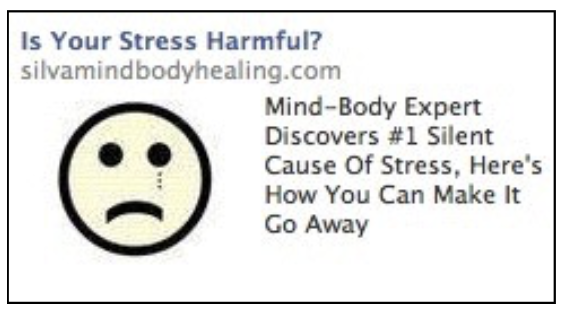
It’s really an awesome ad from a copywriting standpoint. But take a look at the landing page this ad sends traffic to…
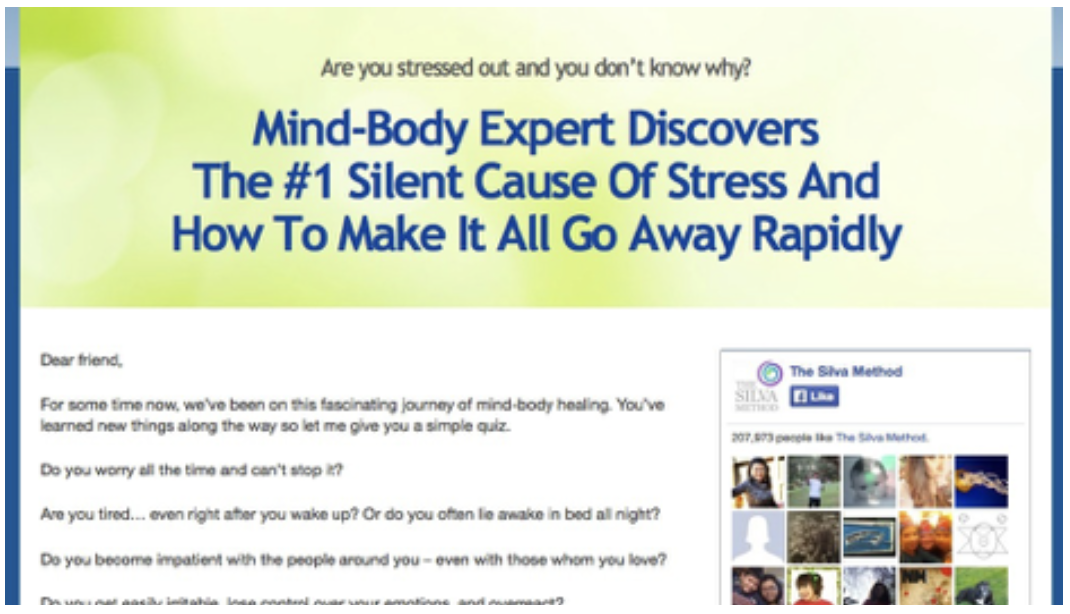
Go back up and look at the ad again. Now look at the landing page. See how congruent the two are?
They didn’t send the traffic to their homepage and hope the visitor can navigate their way to the landing page. They sent them straight to the landing page.
The Key to Success With Traffic Generation
What I really want you to take away from this section of the handbook is this…
There’s no shortage of traffic on the internet. People are bored and constantly looking for something to do online.
The trap a lot of info-marketers fall into is trying to increase the quantity of traffic they’re getting.
The key to success with traffic generation is not about the quantity of traffic you get, it’s about the quality of traffic you get.
Like I mentioned in the previous section, I could pay to get 100,000 visitors to my site tomorrow if I wanted to but it’s pointless if none of them are interested in what I sell.
Always start with the end in mind. What is it you want the traffic to do AFTER they land on your site? Who is the right person for your offer? Where can you find those kind of people? What are those kind of people already searching for online?
When you work backwards like that, it makes the process so much easier. Most people think traffic is the secret to this business. The secret is getting targeted traffic and converting them to buyers.
In reality, the list you build is the secret sauce. And, that’s what we’ll talk about next as we move into System #2.
System #2: Autopilot List-Building
List Building 101
I ended the last section by saying this, the secret sauce that makes this entire business work so well is the list you build.
It doesn’t have to be a list of buyers or customers either. Just a list of interested prospects somewhat targeted to your initial offer.
In the Automated Lead Generation system, I mentioned using a low-priced offer to build a list of targeted buyers. While this is ideal, not every business has this luxury.
Take our gardening niche, for example. Those people are not searching for what we sell. In fact, they don’t even know it exists until they’re already on our list.
We offer it to them later on in the funnel. (A funnel is the term used to describe the sales process of an info-business. A large number of people enter the top of the funnel and a small percentage come out the bottom as customers.)
My point here is not every business can use the same process. Some businesses don’t need to build a relationship with their list before selling something to them.
In the info-business, a lot of times it takes 5 or 6 emails before the prospect can make a decision to buy.
It’s much different when you’re selling physical products. If someone goes online looking for a chest freezer, they’re ready to buy NOW. They know what they need, they know approximately how much it costs and don’t need much persuasion to close the sale.
It’s not so easy in the info-product world. Their are MASSIVE objections to overcome during the sales process.
But, don’t worry…
If you do what I tell you in this guide, you should have no problem overcoming this challenge!
Making Friends On Autopilot
You gotta have a strong relationship with people before they’ll trust your recommendations.
In my opinion, this is what we do best in our info-business… and, we do it on complete autopilot using autoresponders. (More about that in the next section).
Let me take you through our funnel from the start…
Our number one traffic generation method is SEO (organic search traffic). My dad started this business back in 1999 by creating as many unique and valuable articles as possible.
He targeted topics that he knew would attract the prospects who would be interested in his product.
Those articles he wrote back in 1999 are still generating traffic for us on a daily basis, as well as adding new subscribers to our list.
During the winter months we average around 50 new subscribers a day. During spring and summer months we average around 100 new subscribers a day.
But you have to remember, those brand new subscribers have never heard of or seen my dad before they landed on one of our content pages.
It’s up to us to educate these new subscribers on why they should stay on the list.
And we do this with autoresponders. We build a relationship with our list on complete autopilot. We could be on vacation, watching TV or even sleeping… and our new subscribers are being educated as to why they need to listen to us.
That’s the beauty of the info-business. If setup correctly, it will run on complete autopilot 90% of the time.
It’s important to realize how we’ve built our business around our lifestyle. We don’t want to be on the phone. We don’t want to spend hours on Facebook or Twitter “pitching our crap”.
We choose traffic methods that allow our business to run without us.
Don’t lose sight of why you’re interested in this type of business. It’s for the freedom it provides. You shouldn’t be glued to your computer 16 hours a day.
It’s okay to try to new traffic methods and test different things. But in our business, if it can’t run by itself (or be handled by an assistant), we don’t do it.
Say what you want, you’re entitled to your own opinion… that’s just how we want our business to operate.
So… it’s absolutely essential to build a relationship with your list. THIS is the number one secret to our success online.
Next, I’ll show you the right way to use autoresponders to build a relationship with your list on autopilot.
Using Autoresponders the RIGHT Way
An autoresponder (in the email marketing context) is a series of pre-written emails sent to a subscriber automatically at pre-determined intervals.
Let me give you an example…
When someone signs up for our free gardening newsletter, they are automatically put into a sequence of emails that we have already written.
There are 27 emails in this sequence. Each one is sent 6 days after the other. So, lets say someone signs up on a Tuesday, they receive an email from us immediately that gives them a link to download their free gifts just for signing up.
6 days later, they’re automatically sent the next email in the sequence. 6 days after that, they’re sent the third email in the sequence and so on.
The beauty of this process is it’s completely automated. This all happens without any help from us.
It works out to be close to six months worth of emails. One email every 6 days and we have 27 emails total.
Six months is plenty of time to build a good relationship with someone.
Here’s How to REALLY Screw this Up
Marketers are notorious for screwing this up. It’s in our blood to try and sell something every contact we have with people.
You need to refrain from making a pitch. Here’s why…
People are smarter than you think. They know BEFORE subscribing to your “free” newsletter that you will eventually sell them something.
What they don’t know is whether or not you’ll provide them with real value once they’re a “subscriber”.
You have one chance to get this right. If your first email is 80% pitch and 20% content, the unsubscribe button is the first thing they’ll click.
This is where you can really blow people away. This is what we do each and every day and how we get people emailing us saying:
I feel like I know you, like you’re my next door neighbor” and “I just love your down-to-earth tips, they’re so easy to understand” and “I feel like you’re a close friend even though we’ve never met.
We provide REAL value to people by giving them unique content that helps them solve problems they already have.
In our niche, very few others do this. The few that do, aren’t doing it right. They’re doing it manually and paying the price.
Here’s what I mean…
Each week (with exception to the winter months) we try to write at least one blog post. We then email our list and send them to the blog to read the latest post. They LOVE it. That’s what makes them stay on the list.
At the same time, new subscribers are receiving an extra email per week from the autoresponder sequence.
These autoresponder emails are 100% content. Most of these direct the subscriber to our blog to either read older content or watch a video.
What I’m trying to say here is, you have to earn the right to pitch something to your list. You do this by building trust.
Our #1 Way to Build Trust
Video. That’s what’s worked best for us. It cuts the time in half that it takes to build up a trusting relationship. Why? Well, that’s a bit more complicated.
I wrote a blog post about the psychological benefits of using video in your marketing. Even I have to say, it’s a dang good post.
People just respond more to video. They can see you, who you are, how you talk, the clothes you wear, what your office looks like, etc. People are nosey by nature.
Read my post for a full explanation of why you should use video.
Looking back through our autoresponder sequence I discovered 95% of the emails in that sequence include at least one video.
If you’re afraid to get in front of the camera, I urge you to read my blog post. You’ll learn a few tricks to help with that.
It’s definitely not necessary to use video, but it sure does help.
There’s actually many different benefits of video. We upload all of our videos to our Youtube channel, then embed them wherever we want our subscribers to see them.
But anytime anyone views a video (whether it’s embedded on your site or directly in Youtube) that counts as a view. The more views your video has, the higher it will rank in Youtube and in Google.
We get about 10k-15k visitors a month that come directly from Youtube to our website(s). We add a link to our site in the description of each video. We also add links at the end of each video (not clickable links).
But I want you to realize something… people wouldn’t be emailing us telling us they feel like they know my dad if they just read emails that he wrote.
They’re saying that because they watch his videos. I’m telling you, you need to read my blog post about this, it’s freaking amazing.
When Do I Make An Offer Then?
Good question. I never said NOT to pitch something. I said don’t make the pitch the whole reason for emailing them.
The point of your email should be to deliver valuable content. The pitch should just be there for them to click on if it catches their eye.
It’s very rare that we ever send an email out that’s 100% pitch. There’s usually always something of value for the subscriber.
Here’s an example of one of our emails:
Hi {!firstname_fix}
Today is the last day to get My Backyard Growing System
https://www.mikesbackyardnursery.com/2013/03/how-to-make-65%C2%A2-per-square-inch-in-your-backyard/
It won’t be available after today. I’m not sure when it will be available again, we’re busy working on a lot of other things right now.
This box of plants and my dining room table pretty much tell that story.
https://www.mikesbackyardnursery.com/2013/03/how-to-make-65%C2%A2-per-square-inch-in-your-backyard/
This is what you have to do before Christmas. You have to make
some Dirt Farmer Fudge!
https://mikesbackyardnursery.com/2012/12/mike-mcgroartys-dirt-farmer-fudge/
That’s what I was doing yesterday. I made two batches, one with
nuts and one without. And I let the second batch boil over on the
stove. Not good! Not good at all!
Make sure you use a pan that is plenty deep, this stuff expands
when it starts to boil. Use the biggest pan you have!
Anyway, the fudge is killer, I promise.
I’ve got a lot of gardening and plant propagation stuff to share
with you in January and all of 2014 so stay tuned!
Take care and stay inspired!
-Mike McGroarty
P.S. The secret to fantastic fudge is getting it to that perfect
soft ball stage. If you get it right (watch the video) you will
Wow! some folks.
This is a broadcast email we usually send out before Christmas. I highlighted the pitch in the email with yellow.
You got an idea now of how simple our emails are. They’re easy to read, no fancy graphics or templates with clear and concise calls to action.
A lot of people try to mess with this format… adding header images, sidebars full of social media buttons, background colors, etc.
Nothing works better than a plain white background and black text. Don’t try and complicate it.
Final Thoughts
Autoresponders really are a huge piece of our business. Without them our relationship building would be all manual and would take a lot longer.
Don’t dismiss them as something you don’t need in your business.
It’s part of the reason why our business is so successful.
Why You Need to Segment Your List
List segmentation is extremely important in the info-business (or any business for that matter).
List segmentation is breaking your list apart into different groups of similar subscribers so you can speak to each individual group differently.
Here’s why that’s important…
Number one, you can’t sell anything effectively if you’re not speaking to one specific type of person.
Your sales message will be so vague and non-targeted that no one will read it.
Everyone on your list should not be treated the same.
Number two, you will sell A LOT more product if you can segment your buyers from your non-buyers.
You need to speak differently to people who have already spent money with you. They’ve raised their hand and told you they’re interested in what you have for sale.
They’re considered a “hot prospect”. In the info-marketing world, you need to get them while they’re hot. In some cases it doesn’t last very long.
What I mean is this…
That person is in a certain state of mind. Something is going on in their life that’s making them buy. It could be a problem, a diagnosis, an event or a situation.
Whatever that is, they’re coming to you for help. It’s your job to help them as much as you possibly can.
This person is much different from the person that just subscribed to your email list for your free gift.
They don’t even know you yet. They might not even know they have a problem yet.
You can’t send the same email to both of these people. They’re in completely different stages of your sales cycle.
The first one is HOT and ready to spend money. They know you, they like you and hopefully trust you.
The second one is still on their “first date” with you. They’re not sure you’re a good match for them yet.
This is why everyone on your list should not be treated equally.
Don’t worry, I know you’re thinking this may be too complicated for you… setting all of this up. I promise you it’s not.
My dad, who will be 60 in a few weeks, set all of this up HIMSELF back in 1999, which was a long time ago in “technology years”.
Personal computers hadn’t been around too long and he had absolutely no experience with anything related to computers. He was a landscaper by trade and had worked in the plant nurseries ever since he was in high school.
Proof that ANYONE can do this if they really want it bad enough. It’s also proof that it doesn’t have to look glamorous.
People online are searching for answers, not aesthetics. Watch this 54 second Youtube video from marketing legend Gary Halbert.
Gary was a pure marketing genius and what he says in that video is absolutely true. Our business is proof of that.
Anyway, back to list segmentation. You gotta do it. You just have to.
Here are a couple different examples of when I would segment my list:
- A subscriber purchases one of your products
- A customer purchases a second product
- A customer cancels their monthly membership (I would add them to a “please come back” email sequence)
- A subscriber opts in for a different free offer (different from your main lead magnet – meaning they’re interested in a different topic)
And, that’s just a few examples. How I determine whether or not to segment someone is based on their interests as a subscriber.
Obviously, someone who has purchased something deserves to be on a customer list where you can sell them something else.
But even just a subscriber who hasn’t given you money yet who shows interest in a different freebie you make available is a good prospect for segmentation.
You want to be able to talk to them directly about the new interest they have. Segmentation is an absolute MUST in your info-business.
Extracting Money from Your List
Making Money is the number one reason for starting a business, right? It’s also the number one reason people go out of business.
The x-factor here is… your intent.
Your subscribers can see right through your sales pitch. They can smell sales people from a mile away.
Extracting money from your list is a fine art.
But if you follow my advice from the previous sections about building a trusting relationship, you’ll be much better off.
You have to put your subscriber’s well-being before your own. Think of your email list as a family member. How would you treat a family member if you were giving them advice?
You wouldn’t spend 90% of your time trying to sell them something, right? No. You’d take the time to GIVE them as much as possible and at the same time making them aware you have a solution to their problem.
They should know that you truly care about them and what they have going on. There’s no faster way to ruin that relationship you spent so much time building than to “pitch” them something irrelevant to what they need.
How We Safely Extract Money
1. We don’t send an email out to our main list WITHOUT including some kind of value.
They’re gardeners so we typically will include a link to a new blog post or a new how-to video we recently shot. We always have a “reason” for emailing them besides making a pitch.
2. We don’t make the pitch in the email… ever.
The email includes a call-to-action that sends the subscriber to a landing page (or sales page in some cases).
Each piece of your email marketing should serve a single purpose. The subject line of your email gets the subscriber to open the email. The first line of the email gets the subscriber to read the second line. The call-to-action of the email gets the subscriber to click through. Etc, etc.
Don’t try and make the sale in the email. You want to get the subscriber to take a few actions. Even the tiniest of commitments (like clicking a link), psychologically changes a person’s thinking.
They’ve subconsciously made up their mind that they’re going to focus some attention on your offer.
It’s much easier for the subscriber just to delete your email if you include the entire pitch right inside. There’s no tiny commitment for them to make.
3. We segment our list for each offer we make.
We don’t try to sell our entire list on each offer. A short call-to-action is made in each email that sends subscribers to a squeeze page where we ask them to opt-in to receive more information about the offer.
If they don’t opt-in, they don’t hear anymore about the offer from us… which to us means they’re not interested.
And that’s fine. We don’t want to keep jamming the offers down their throat, forcing them to look at it. If they’re interested, they’ll opt-in.
Once they’re opted into the new list, we’re free to talk to them specifically about that offer and anything related. Now, we have a separate list (or a segment of our existing list) who has raised their hand and said they’re interested in this specific topic.
Here’s an example of a squeeze page we send people to for one of our offers…
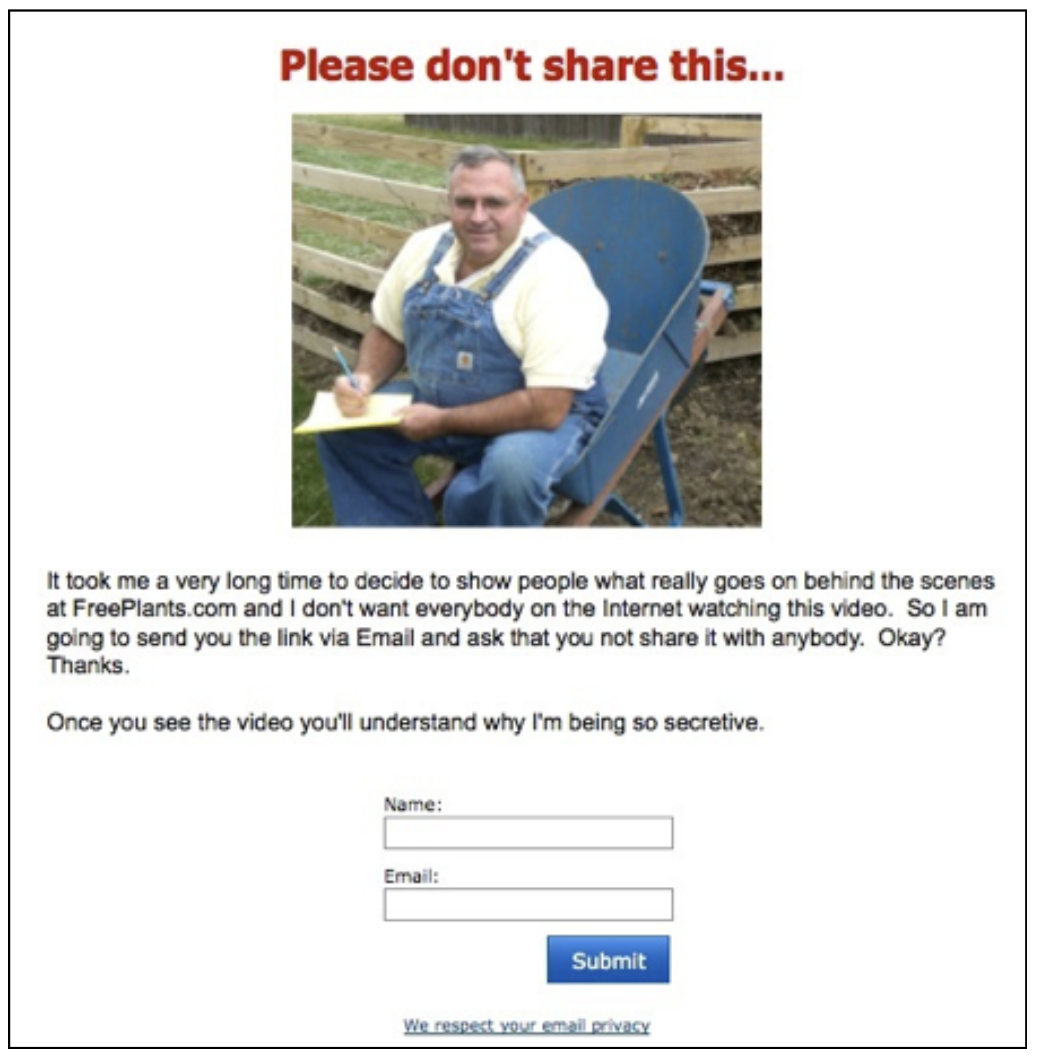
We used this page to segment people who were interested in learning more about running an online business.
Here’s another squeeze page we used to promote an affiliate product, notice how simple these squeeze pages are…
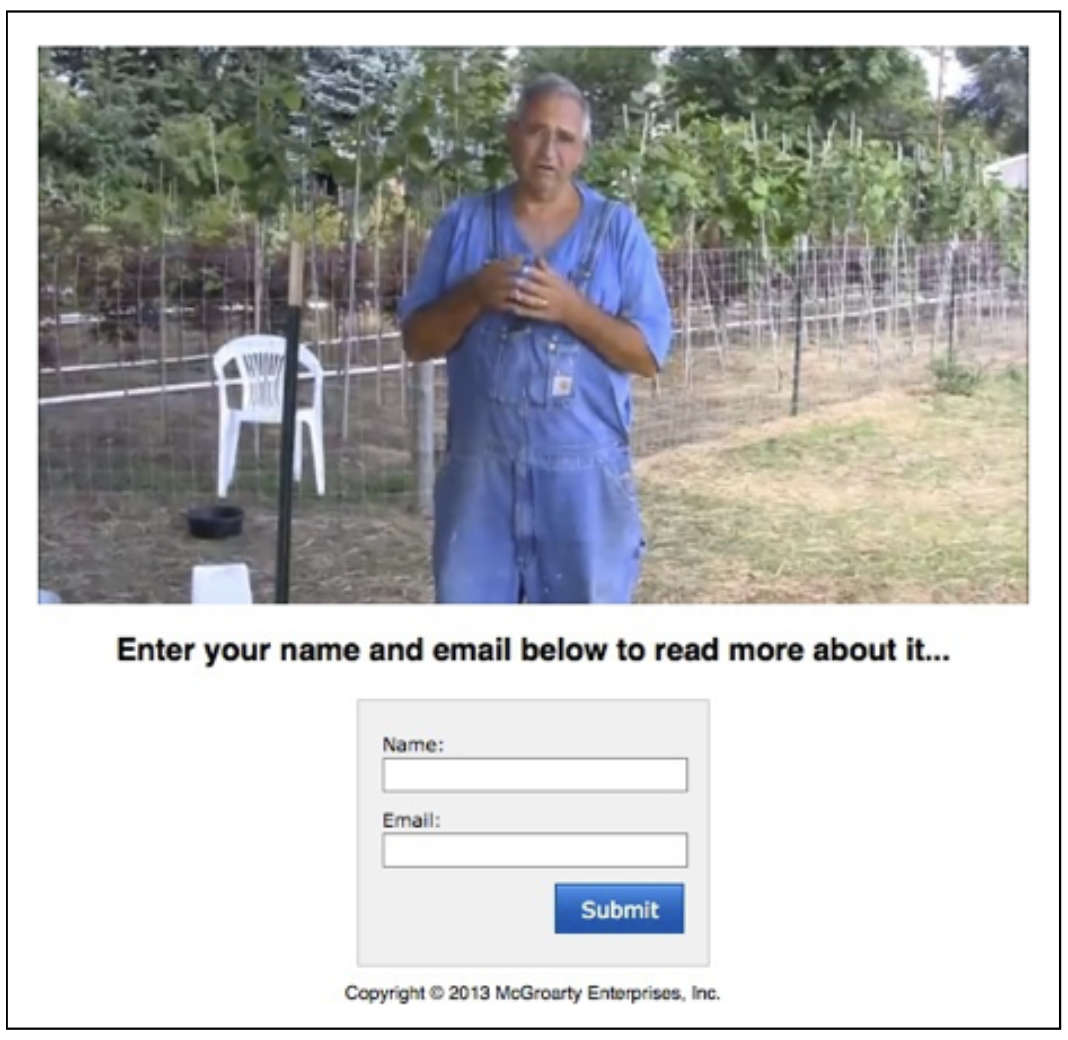
The video on this page is no more than 4 minutes long and briefly describes the offer and what the subscriber can expect to happen after opting in.
In this case, we redirected the subscriber straight to the sales page for this product after opting in. It was a $27 product that really sold itself.
That’s the beauty of building a trusting relationship with your list… when you make a recommendation, they jump all over it because they trust you. Using video just enhances the trust even more.
Get this… the above $27 offer was for a set of 104 how-to videos about setting up a website and running an online business. Weird, right?
Our email list is gardening related! And we’re pitching them internet marketing products. In less than a few weeks time, we made around $8,000 promoting this affiliate offer (our commission was only $13.50 per sale – 50% of $27!).
THAT’S how powerful this list building stuff is!
Here’s another squeeze page for a different product…
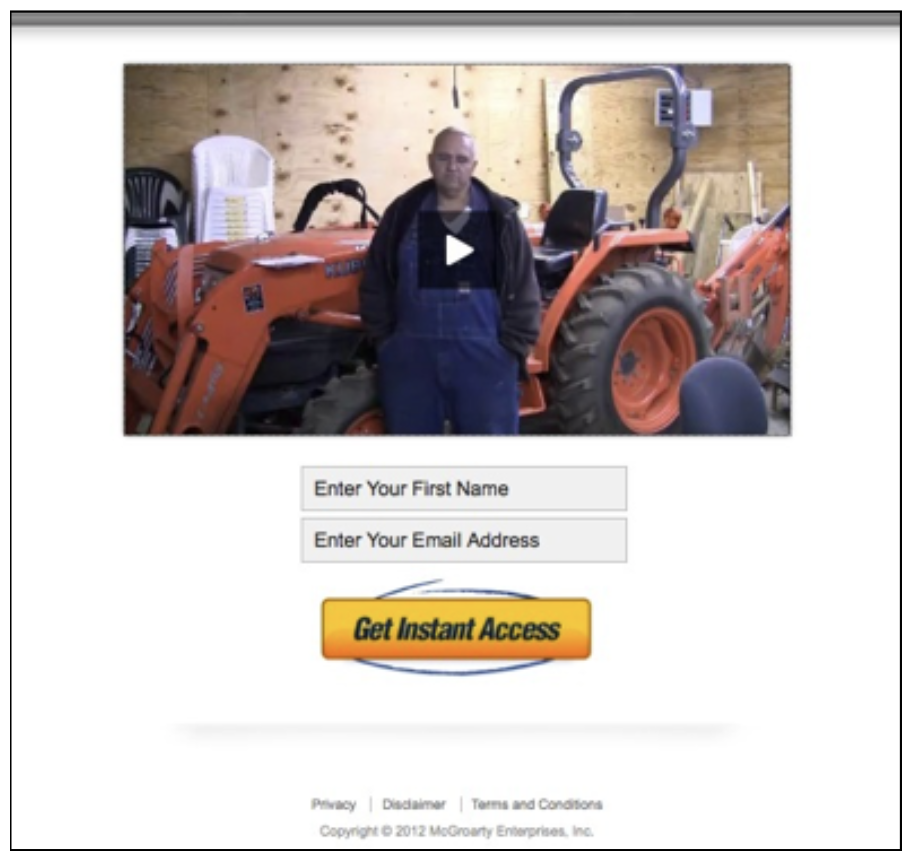
Are you seeing a pattern here? Going back to our discussion about landing pages and squeeze pages in System #1, when someone lands on your squeeze page, they should have two options. One, they can opt-in for your offer or two, they can leave.
That’s it. Limit the number of options they have. Don’t distract them.
The great part about this whole system is now we have a bunch of targeted sub-lists of people who raised their hand and said they were interested in a certain topic.
That information is priceless!
One more thing I want to point out before moving into System #3 is, video works well for us… that doesn’t mean it will work well for you. My suggestion is to split-test your squeeze page with and without video.
Never assume anything in the info-marketing world. Only trust the results from your own tests. Every niche is a little different. Not everyone responds to video. Some ONLY respond to video.
You don’t know for sure unless you split-test it.
System #3: Multiplying Profits
How to Put Your Sales Funnel On Steroids
Picking up from where I left off in System #2, I showed you how to extract money from your list by sending your subscribers to a squeeze for a specific offer and having them self-segment themselves.
Here’s a visual example of what this looks like for us…

Now, this is just the prospect funnel. This is what happens before the subscriber gives us any money.
Once the subscriber spends money, our sales funnel switches into full gear. Lights start flashing, the ground shakes and steam comes pouring out from underneath.
Seriously though, it’s a whole new ball game when someone gives us money. They’re treated completely different than just a regular subscriber.
We remove them from the main gardening list and they’re added to one of our “customer lists”, depending on which product they buy.
Actually, let me take a step back…
Before any of this happens, you have an opportunity to make more money from this customer with what’s called an upsell.
If you’ve been in the marketing world for any time at all, you probably know what this means but just in case, here’s what Wikipedia defines it as…
“Upselling is a sales technique whereby a seller induces the customer to purchase more expensive items, upgrades, or other add-ons in an attempt to make a more profitable sale.”
The first instant upsell we ever had was so dang simple it’s almost too good to be true.
I saved the upsell page we used which you can see below.
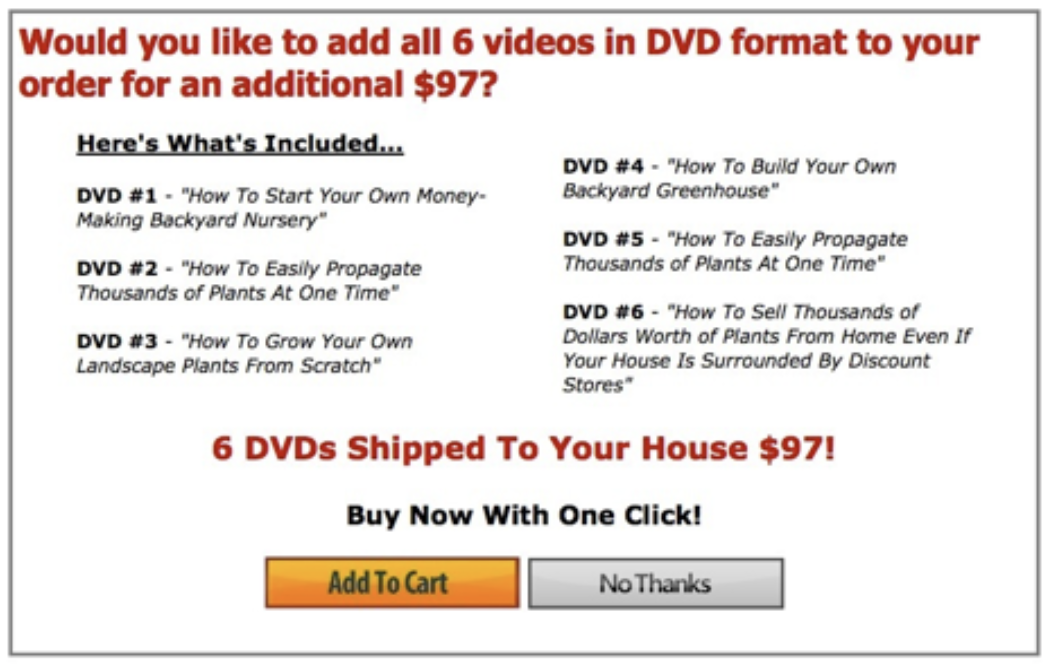
I will tell you this though, it converted at 26%… meaning 26% of the people who bought our $37 product, bought this $97 1-click instant upsell.
That’s a big profit maximizer right there!
This was offered to them through our shopping cart (1shoppingcart) right after they finished checking out. It’s called a “1-click upsell”.
The cart saves their information (including their payment info, securely of course), shows them this page and if they click the “Add to Cart” button, it automatically charges them another $97 without them having to enter their info again.
In this case, it didn’t take much of sales pitch to close the deal. They were already getting digital access to these videos so offering a hard copy only made sense.
It’s an older demographic and watching videos on their computer isn’t an easy sell.
So, instant upsells could be a huge improvement to your business. When people are in a buying mood, it doesn’t hurt to capitalize on that, just as long as you’re providing them with quality products.
Instant upsells can totally destroy your business if done incorrectly. If the new customer has any inclination that they need to buy the upsell for their initial purchase to work, you could lose both sales.
Here are some examples of good upsells…
- Done-for-you services
- Complimentary products that aren’t related to the initial products but could still be related
- Software that enhances the initial purchase by speeding it up or automating it
That’s just the tip of the iceberg. It really depends on your business and who your prospect is.
Building Out Your Backend
The backend means the products/services you offer after the initial sale… it’s the backend of your funnel.
And, it’s really very similar to the frontend, or the part subscribers go through before the initial sale, except it’s a lot more narrowly focused.
Instead of offering your new customers a broad range of products, you offer them products closely related to the one they purchased. Makes sense, right?
It will make more sense as we move into the next section.
What is LCV and Why is it Important?
LCV stands for Lifetime Customer Value. Basically, it refers to the amount of money one of your customers is worth to you over the period of time that they’re your customer.
Do a search for this in Google and prepare to step back into your high school math class. Seriously, it doesn’t need to be that hard.
For what you’re doing, you don’t need an exact LCV down to the decimal point. All you need is a close guess.
Lets start by figuring out what a customer is potentially worth to you. This number is easy to figure out. Just add up the total of all of the products in your funnel for that specific type of customer to buy.
Lets say you have 4 products you offer to that one specific customer… one is $7, one is $27, one is $97 and one is $297. Your potential customer is worth $428 to you.
That’s the most you will ever get out of any of your customers. But here’s the problem… some will buy all of your products and some will just buy the $7 product.
That’s where the “geeky” LCV formulas come into play. They help predict what your LCV will be. When you’re just starting out, there’s really no way to come up with a true LCV. You just need to get some sales under your belt and reevaluate your numbers later on.
Once you have a decent amount of sales you can come up with a guesstimate for your LCV. Here’s something you can do after a month’s worth of sales or better yet, a year’s worth of sales, do the following simple formula…
Total Revenue / # of Customers = Average LCV
This is a pretty simple formula once you break it down. What we’re trying to do is determine what the average customer is spending with you.
To do that, you take your total sales for a select period and divide it by the total number of customers who ordered during that period.
Let me give you an example…
Lets say your total sales last year were $100,000 and you had 500 customers order something from you during that time. That would mean, on average, a customer is worth $200 to you.
Now, those are nice round numbers but you get the idea.
So, how can you utilize what we just learned? Why did I just spend 5 minutes of your time teaching you about LCV?
Because it’s important… HUGELY important.
The businesses that know their numbers, win this game.
What I mean is, if you know what a customer is worth to you, you also know how much you can spend to acquire them while still making a profit.
BIG LESSON right there. Read that paragraph again.
Think of it like this… there’s an endless sea of prospects out there who would be interested in buying your product. An ENDLESS amount. Not 1,000, not 10,000, not a million… an endless amount.
If you could PROFIT $10 (right into your pocket) from each one, how many would you want?
As many as you can get, right?! Right. But why only $10? If a customer is worth $200 to you, why only $10?
Who cares?! An endless sea of $10 bills is exponentially better than a fixed number of $100 bills.
That means you could spend $190 on advertising to a SINGLE prospect. I can guarantee you no one is spending that much money with a customer value of $200.
Now, I’m not saying you should do that but if you knew there was an endless sea of prospects and you could make $10 off each one, you could spend $190 to acquire them.
Whoever can spend the most to acquire a customer and still make a profit will always be the winner in this game.
This is why it’s so important to always be looking for a way to increase your LCV. Always.
It doesn’t have to be instantly either.
LCV means LIFETIME customer value, not immediate customer value. Some companies go years before breaking even on their advertising. But they know well in advance how much that customer is worth to them over the course of their life.
A great example of this are the banks. People rarely think of the banks as a business when in reality, they’re the most profitable and lucrative businesses in the world.
New customers are literally born every day for them… literally born. Newborn babies are their best prospects.
Before the baby even makes it home from the hospital, the banks are calling up the government, getting mailing addresses of the brand new parents and selling them on a 529 college savings plan.
Before the baby even leaves the hospital!
The banks will spend years promoting the 529 plan until one day, the parents finally say, “you know, we should probably start saving for little Timmy’s college”.
BAM! After six years of spending money trying to acquire the customer, the bank finally gets a return on their investment. BUT… they haven’t broken even yet.
They don’t break even until the day little Timmy is no longer little and he needs a loan for his brand new car.
Now, after another 12 years, the bank is finally seeing a profit.
Then, a few years later… it happens. The ultimate return on investment. Timmy buys a house… a big house, in a gated subdivision.
After waiting so patiently, the bank’s plan finally comes full circle.
That, my friend, is how you “go negative” to acquire a customer.
Last thoughts about LCV…
I can’t say it enough, you gotta know these numbers is you want to take your info-business to the next level.
Paying for traffic is likely out of the question for you if you can’t make the numbers work. Dan Kennedy is known for saying…
“Good marketing can’t fix bad math.”
No matter how good your marketing is, your business will never be successful if the math doesn’t work out.
Basically, that means if you’re acquisition cost is more than your LCV, there’s no chance for success.Get your numbers right and work on increasing your LCV.
How to Automate Your Sales Funnel
I want to keep stressing the fact that automation is your friend in this business. Spending money on software that will automate mundane tasks is required for you to be able to experience the freedom you’re hoping for.
Now, don’t freak out… you don’t need to spend thousands of dollars a month on software.
There’s really only 3 things you need:
- A Website (obviously)
- A Shopping Cart with a Merchant Account
- An Autoresponder
That’s it. Don’t complicate this, please. There are people out there trying to get you to buy fancy WordPress plugins, templates, themes and who knows what else.
Just remember, those three items are all you need to get started.
Down the road, after you have a steady stream of income, you can think about investing in that other stuff. But right now, focus on those three things.
Lets go over each one a little more…
1. A Website
An obvious requirement for anyone trying to sell stuff online. But how you structure it and the tools you use to do so, is what will set you apart from the other 100 million sites online.
Now, there are a few ways to go about this and it really depends on your plans for the business.
As far as squeeze pages, landing pages and sales pages go, a plain HTML site will do just fine. There’s no need to run these pages through WordPress. WordPress is made for blogging. That’s what it was built for. Trying to do more than that with it will just cause you stress.
Remember, after you have a steady stream of income, then you can experiment with whatever you want.
Right now you need to focus on making money, not spending it.
So, if blogging is part of your plan for your info-business, WordPress is the way to go… for that. Don’t think just because you have WordPress setup for blogging that you need to try and use WordPress for your marketing pages. You don’t.
You can have regular HTML pages on the same site, same domain name as the WordPress blog.
There are tons of WordPress plugins and themes out there built for marketers that include squeeze pages, landing pages and sales pages.
Personally, there are only two page builders that are worth the money. Here’s a post I wrote comparing them: ClickFunnels vs. Leadpages: A Veteran Marketer’s Blatantly Honest Review.
2. A Shopping Cart with a Merchant Account
You need a way to take money from people. I’m not talking about an e-commerce shopping cart like something Amazon uses. I’m talking about an order form, in reality.
You want people to be able to click an Order button on your sales page and be directed to an order form where they enter their payment info. That’s it.
There’s no need for a fancy cart with product images, banners, etc. Just a simple order form.
If getting a merchant account scares you, you do have a few other options.
There’s nothing wrong with using PayPal when you’re first getting started. It serves the purpose.
Here’s where it creates a problem though…
When you want to include an instant upsell in your sales funnel (like the one I showed you that we used earlier), PayPal will not allow it.
The only option you have with PayPal is which page you want to send the user to after their order is complete. AND… they have to click a button inside of PayPal to be sent back to your chosen page.
From there you can make them another offer but in order for them to take you up on it, they would need to enter all of their payment info again into PayPal.
You can quickly see how cumbersome this process is for your users.
Like I said, if PayPal is all you can afford or all you can wrap your head around when you’re getting started, that’s absolutely fine. It works. Get some cash flow going and then move on to a more streamlined process.
ClickFunnels is also another great option. It integrates with Stripe and offers tons of features for marketers (including 1-click upsells).
Here is what we use for our gardening business… we use 1shoppingcart for our shopping cart and authorize.net as our payment gateway/merchant account.
Together they work flawlessly. We’ve had this setup for many years. We tried moving to Infusionsoft last year and had the hardest time making it work. Simple is always better.
1shoppingcart dummy-proofs the process whereas Infusionsoft expects you to be a technological genius to complete the setup. Not cool.
Everything you will ever need to do in your info-business can be accomplished with 1shoppingcart.
Instant upsells, downsells, cross-sells, multiple upsells, recurring billing, trial offers, affiliate programs, email marketing (which I don’t recommend through 1shoppingcart, I’ll tell you why next), tons of payment gateways, PayPal integration and a bunch more.
Here’s an important piece of information that I just learned about 1shoppingcart yesterday actually…
They have two different types of shopping carts, an e-commerce option which is what you see if you go to their homepage or a “landing page” option.
The landing page option is what you want and it’s what we use. To learn more about the landing page packages they have, go to this page. They currently are giving you a free 4-week trial to the “Professional” package, which is the one you’ll need if you want the ability to do 1-click upsells.
Again, it’s not required right out of the gate but I highly recommend it for getting the highest LCV possible.
3. An Autoresponder
This is easy. I have only one recommendation here and you’re crazy to go with anyone else. Aweber is the go-to solution for email marketers.
They are hands-down the best at what they do. When you’re picking out an email marketing company to use, deliverability is the number one thing you should be looking at.
Here’s a snapshot I took from a page on Aweber’s site…
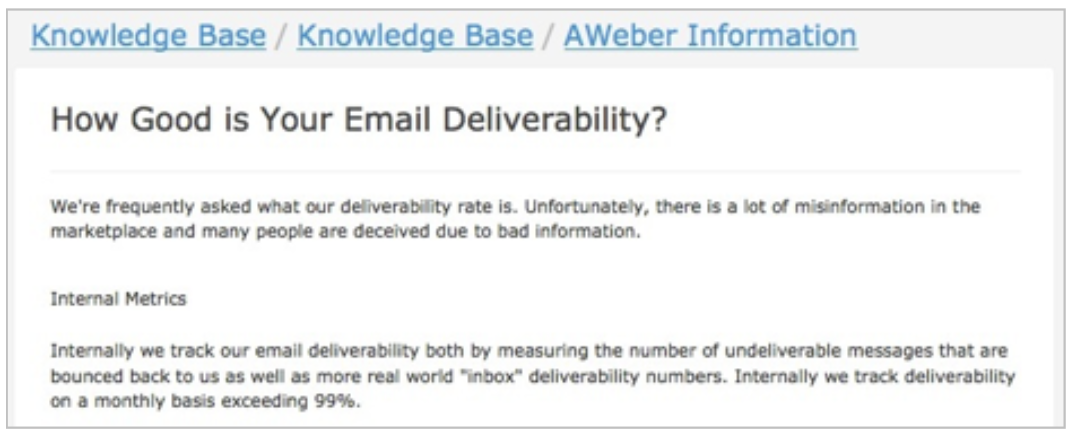
In case you can’t read that, their email deliverability rate exceeds 99% on a monthly basis.
Meaning, more than 99% of the emails they send out on behalf of their customers get delivered to an inbox and not a spam folder.
That’s huge.
We’ve been using Aweber since 2004. They’re pretty affordable with packages starting at $19. You pay based on the number of subscribers you have.
How to Automate the Whole Dang Thing
Now that we’ve got our 3 key tools, it’s time to integrate them all and connect our entire funnel. All three independent systems you learned about (lead generation, list-building and profit multiplying) will now be connected together using these 3 tools.
This little diagram I created shows how this all fits together visually…
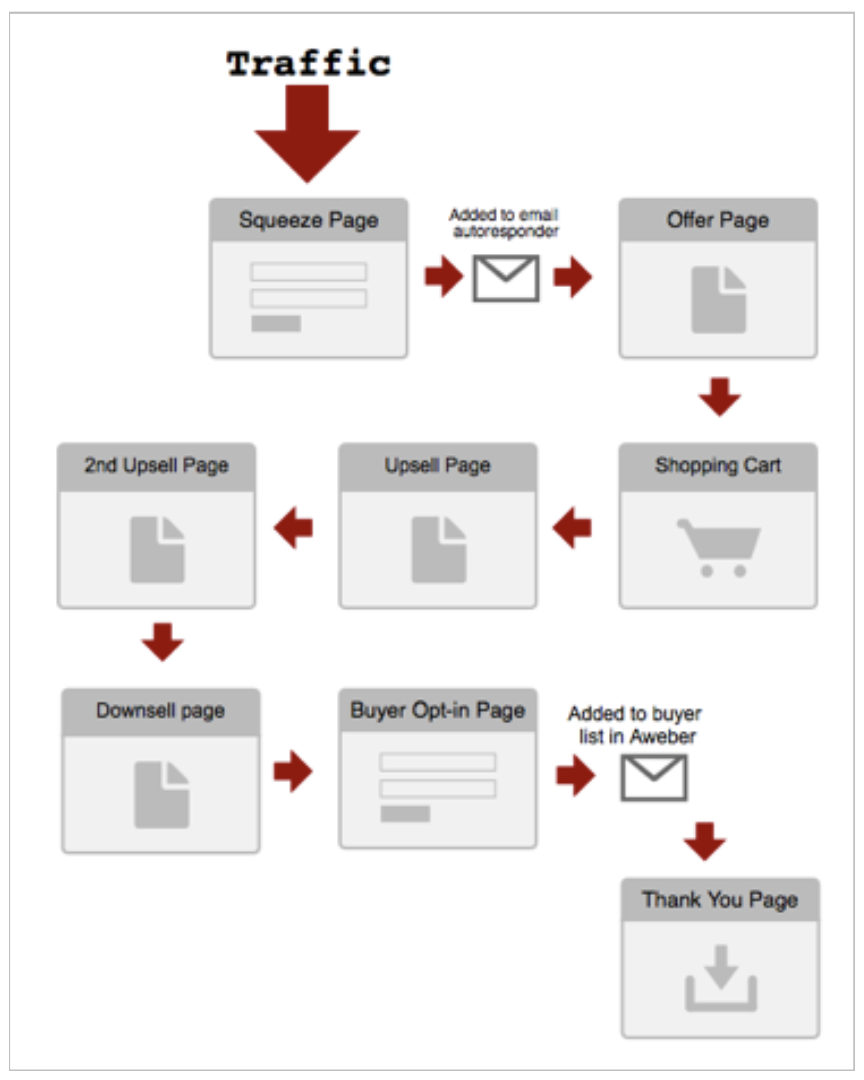
I think this diagram does a pretty good job of explaining how these all connect together.
Traffic lands on your website, preferably a squeeze page or landing page, and they opt-in to receive the offer.
From the moment they opt-in, the email autoresponder takes over, adding that person to your email list and setting them up to receive your autoresponder messages.
Your autoresponder then builds the relationship with that subscriber over time. Eventually they’re introduced an offer that interests them and they decide to buy.
They click the Order button which takes them to your shopping cart order form where they enter their payment information. After they Submit their order, the shopping cart immediately offers them any 1-click upsells you might have.
If they take the first upsell, the shopping cart shows them the next upsell. If they don’t take the first upsell, the cart shows them the downsell.
Once they’ve made it through the offers, they’re taken to the page you’ve designated in the shopping cart as the “Thank You Page URL”. In this case, it’s really just an opt-in page where the buyer adds themselves to a buyer list in your autoresponder. (Note: if you use ClickFunnels and integrate it with Aweber, buyers can automatically be added to your email list based on the products they purchase.)
Now, the autoresponder sets them up to receive autoresponder emails regarding their purchase.
After they opt-in to the buyer’s list, they’re redirected to the real thank you page where you can thank them for the order.
This is by no means the only way to set this up. This is just the simplest way AND, it’s completely automated.
The software handles everything. You set it up once, send traffic to squeeze page and watch the magic happen.
Don’t worry about actually integrating your Aweber account with 1shoppingcart. They say it’s an option, and it is, but it’s not effective. It’s easier to just send the buyer to an opt-in page where they can add themselves.
Since this is the first page they see after completing their order, thank them for the order and tell them you need their name and email so you can keep them updated with any changes made to the product.
In our case, our front-end product includes an ecourse which will start as soon as they enter their name and email address.
Here’s what one of our “thank you” opt-in pages looks like…
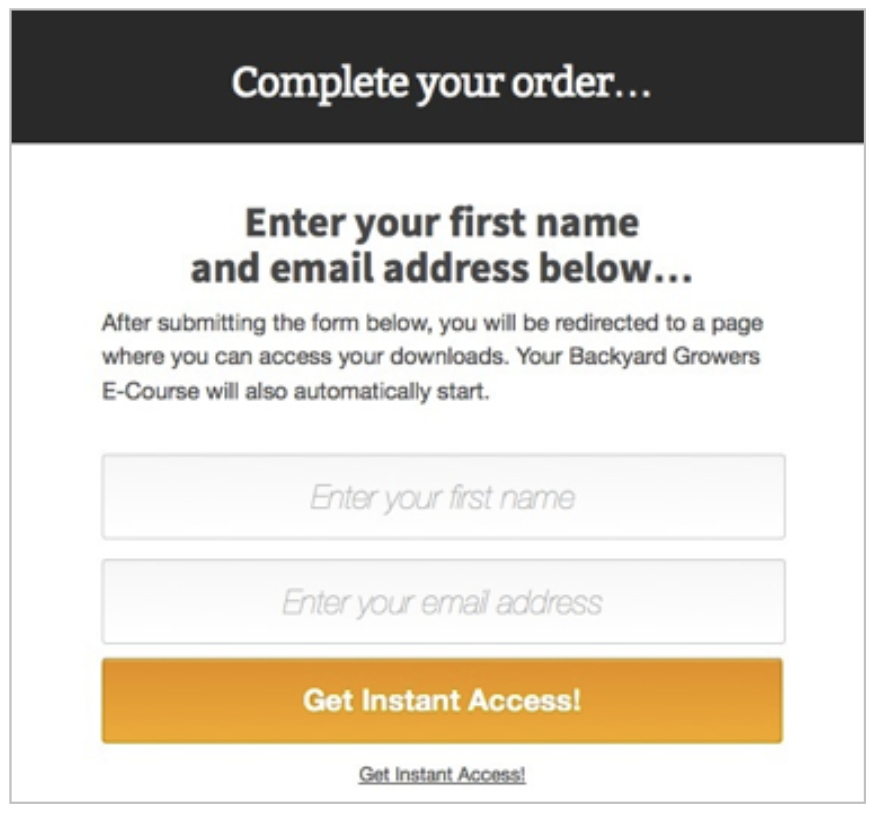
That, in a nutshell, is how to automate your entire sales funnel.
Like I said earlier…
There are TONS of ways to complicate this process. Tons. What I just showed you is EXACTLY what we use and we’ve been using since 1999.
Be careful of distractions and “shiny objects” in the marketing world, you have no idea what kind of damage they can cause.
Simplicity plays a huge factor in the success of our business.
Adding a Recurring Revenue Stream
Last year, recurring revenue accounted for 45% of our business online. 45%!!!
Do you realize how HUGE that is?!
It’s astronomical.
There’s no faster way to increase your LCV than by adding recurring revenue to the backend of your funnel.
Every successful info-business uses it, and for good reason.
But why? Why should you have a recurring revenue product? Well, for a number of reasons.
1. Profit Multiple Times from 1 Sale
This is the real beauty of recurring revenue. You only have to make the sale one time but you can get paid from it over and over.
2. Train Customers to Pay You for Information
Psychologically, recurring payments change the way your customers look at you. By paying you monthly for information (or anything related) they get used to coming to you for more. It trains them to give you money in exchange for something of value. Just be sure to continue to provide value.
3. Keeps You at the Front of Your Customer’s Mind
Similar to #2 above, if you’re providing something for your customer on a monthly basis, you stay at the front of your customer’s mind. When they need something, they come to you.
4. Increase LCV
This one is pretty self-explanatory. Multiple sales are better than one and you only have to sell it one time. It’s definitely the fastest way to increase your LCV.
That’s just a few reasons why you should think about adding a recurring revenue product to your funnel.
Examples of Recurring Revenue Info-Products
Newsletters
Newsletters are probably the most common recurring revenue products. But with a paid newsletter, you really need to focus on providing great value each and every month.
I’ve seen a lot of newsletter subscriptions come with tons of different kinds of bonuses for example, audio interviews, templates and scripts.
Community
This is actually what our recurring revenue model. We have a private community that members pay to belong to. Ours is setup as a micro-continuity membership where they pay $7 for a 30 day trial and then 9 payments of $67 after that. Then, they’re a paid up member and have no further payments.
Membership Site
Similar to the community model, a membership site is a very lucrative way to generate recurring revenue. You could provide exclusive content or materials only available to members or you can just include a forum for members to ask questions and give answers.
Email Courses
Charging monthly for an email course is another great option. I’ve sold a few of the types of courses myself.
You just use an autoresponder like Aweber to deliver emails once a week, twice a month or once a month and the member is charged monthly to continue to receive lessons.
Templates
People will pay X number of dollars a month for a specific template. For example, a newsletter template. I know someone who does just that. They provide a newsletter template, with a bunch of generic content already added, and businesses pay them every month for that service.
Done-for-You
This may a little out of your league right now but down the road it could be a great option for you business.
For example, a lot of people offer SEO services to local businesses on a monthly basis, including me.
At this point, I have someone else do the work while I take payment from the business. It’s still recurring revenue and it requires no work from me.
Conclusion
What I’ve given you here is a map to millions. That’s no bull. We’ve sold close to $5 million worth of info-products, just to gardeners, using this exact model.
If you follow the steps I’ve laid out for you in this guide, you could be well on your way to financial freedom.
Will you get rich? I don’t know, I can’t promise you that. It’s up to you to put forth the effort to make this happen. Nothing will happen unless you take action.
I know you’ve probably been told that a hundred times… “you need to take action”, “action speaks louder than words”. Yeah, yeah, yeah. Well, what’s your plan?
How are you going to make this happen? I suggest you sit down with a pad and pen and write something out. Get it down on paper then you can go back through it all, cross stuff out, add stuff and move stuff around.
You need a game plan though, a checklist, a goal timeline. Anytime I’m creating a new product or setting up a new funnel, I create a project management spreadsheet.
It sounds more technical than it is, really. I use SmartSheet so I can share it with anyone that I want to see it, they can add stuff or make changes and it can be accessed from any device with an internet connection.
Here’s a snapshot of the sheet I created for this guide…
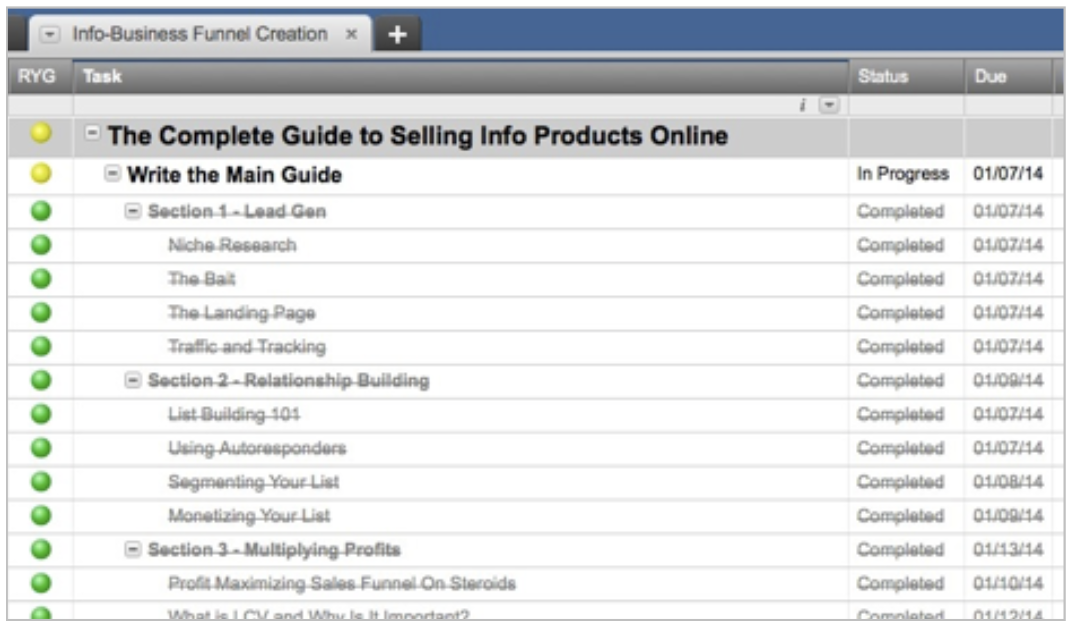
It’s pretty simple… it includes each task, what the current status is of the task and the date that I want to accomplish the task.
It really makes setting up a new business easy. When it’s all in your head, there’s no organization, you have no clue where to start, what’s next and what you should be focusing on now.
When I use a spreadsheet like this, I can plan my week out better and manage my time a lot easier. It also sparks a little fire under your butt to get stuff done sooner than your due date.
Weird how seeing it on paper changes your perception of the task. I’m not sure how, but it works.
You don’t need SmartSheet either. The same thing can be done in Excel or OpenOffice. The key is to just get it done. Don’t waste time “researching” stuff online.
I left very little out of this guide (other than some “how to” stuff which you can get with a quick Google search).
The last thing I want to leave you with is this…
Simplicity has it’s advantages, don’t make things more complicated than they need to be.
Everything we do is based on this principle and it’s never let us down.



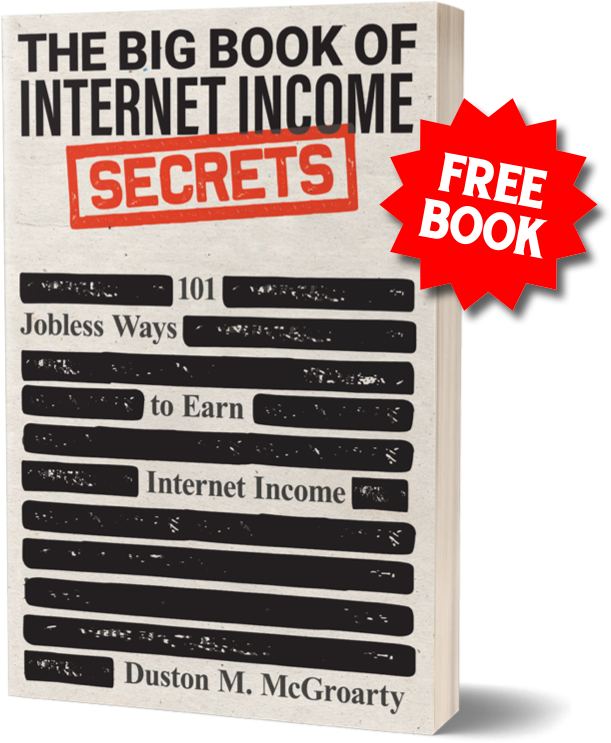

2 Responses
That may be the best advice anyone has ever had! I am changing my squeeze page now!
Beautiful ❤️